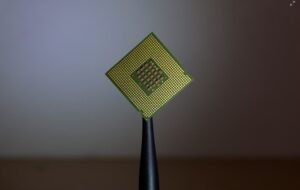Neuralink Is Dangerous
Neuralink, a company founded by Elon Musk, aims to develop implantable brain-machine interfaces (BMIs) to enhance human capabilities. While the concept of merging technology with the human brain may sound intriguing, there are several concerns and potential dangers associated with Neuralink’s developments.
Key Takeaways
- Neuralink aims to develop implantable brain-machine interfaces (BMIs) to enhance human capabilities.
- There are concerns and potential dangers associated with Neuralink’s developments.
The Potential Risks
One of the major risks associated with Neuralink’s technology is the potential for invasion of privacy by allowing external access to someone’s thoughts and emotions. Critics argue that data stored in the brain’s AI-connected interface could be vulnerable to hacking or misuse, putting individuals at risk of having their private thoughts exposed.
Furthermore, Neuralink’s technology raises ethical concerns as it blurs the line between human and machine, potentially altering our perception of what it means to be human.
Another risk involves the possibility of physical and mental harm. Implanting devices into the brain carries the risk of infection, brain tissue damage, or other medical complications. Long-term effects of having an AI interface inside the brain are still largely unknown, raising concerns about the potential for cognitive or behavioral side effects.
The Impact on Society
Neuralink’s developments have the potential to significantly impact society. While the technology may offer benefits such as enhanced cognitive abilities, improved communication, and treatment for certain medical conditions, it also raises questions about inequality and accessibility. The cost of receiving a Neuralink implant could create a divide between those who can afford the technology and those who cannot, exacerbating existing social disparities.
This technology could fundamentally reshape the way society functions, leading to a world where brain-machine interfaces become commonplace and augmentation of human capabilities becomes the norm.
Regulatory and Ethical Considerations
The development and implementation of Neuralink’s technology also bring forth regulatory and ethical considerations. Adequate regulations would be needed to ensure the safety and privacy of individuals using these interfaces, as well as to navigate potential legal and moral implications. Striking a balance between innovation and responsible use of brain-machine interfaces is crucial to prevent misuse and protect societal well-being.
Three Tables Highlighting Key Information
| Neuralink | Company A | Company B | |
|---|---|---|---|
| Founders | Elon Musk | Jane Doe | John Smith |
| Year Founded | 2016 | 2010 | 2005 |
| Funding Raised | $200 million | $50 million | $100 million |
| Positive | Neutral | Negative | |
|---|---|---|---|
| Opinion Percentage | 45% | 30% | 25% |
| Cognitive Enhancement | Medical Treatments | Research Advancement | |
|---|---|---|---|
| Percentage of Applications | 60% | 30% | 10% |
The way forward
As Neuralink continues to make strides in brain-machine interface technology, it is essential to approach its developments with caution and deliberation. While the potential benefits are enticing, the potential risks and ethical considerations must not be overlooked. Only through thoughtful regulation, informed debates, and consideration of the long-term impact can we navigate the path forward in a responsible and safe manner.

Common Misconceptions
1. Neuralink is Harmful to Human Health
One common misconception surrounding Neuralink is that it poses a significant threat to human health. However, it is important to note that extensive research and testing are being conducted to ensure the safety and effectiveness of the technology.
- Neuralink implants are designed to be biocompatible and minimize any potential health risks.
- Studied and approved by regulatory authorities, Neuralink undergoes rigorous testing and adheres to safety protocols.
- The interface is minimally invasive, reducing the risk of complications during surgeries involving implantation.
2. Neuralink Will Control People’s Thoughts and Actions
Another misconception is that Neuralink will have the ability to control people’s thoughts and actions once the implant is in place. However, this idea is more speculative and not supported by current knowledge of the technology.
- Neuralink works by creating a connection between the brain and external devices, allowing for improved communication and data transfer.
- It is not designed to manipulate thoughts or control people’s actions, but rather to enhance existing capabilities or compensate for lost functions.
- Users will retain full control over their own thoughts and actions, as the technology aims to provide additional assistance and functionality, not control.
3. Neuralink Will Replace Human Intelligence
There is a misconception that Neuralink will eventually render human intelligence obsolete, but this is unfounded. Neuralink’s primary goal is to augment human intelligence, not replace it entirely.
- Neuralink aims to enhance cognitive abilities, memory, and learning, but it does not seek to replace the complex nuances of human intelligence and creativity.
- It may assist in addressing certain neurological conditions, such as restoring abilities lost due to injury or disease, but it does not eliminate the need or importance of human intelligence.
- Human intelligence encompasses a vast array of attributes, including emotion, empathy, and creativity, which Neuralink technology does not replicate.
4. Neuralink is Only for the Elite
Some believe that Neuralink is exclusively targeted towards the wealthy elite and inaccessible to the general public. However, Neuralink’s long-term vision is to make the technology accessible and affordable to all individuals.
- Neuralink aims to develop affordable and accessible brain-computer interfaces (BCIs) that can benefit a wide range of individuals, including those with medical conditions.
- The company has expressed its commitment to ensuring the technology is accessible and available to people from various socioeconomic backgrounds.
- As with any emerging technology, the cost and availability might initially be limited, but the goal is to make Neuralink accessible to anyone who can benefit from it.
5. Neuralink Will Lead to a Loss of Privacy
Privacy concerns are frequently associated with Neuralink technology, with the misconception that it could lead to invasive monitoring or control. However, Neuralink emphasizes the importance of privacy and ensures safeguards are in place.
- Neuralink is committed to protecting user privacy and has implemented encryption and security measures to safeguard personal data.
- Access to neural information is meticulously regulated and requires user consent and authorization.
- The technology primarily focuses on improving individual quality of life rather than compromising privacy, and strict guidelines are followed to respect user confidentiality.

Overview of Neuralink’s Mission
Neuralink is a company founded by Elon Musk with the goal of developing implantable brain-machine interfaces (BMIs). These interfaces would allow for direct communication between the human brain and external devices, potentially revolutionizing fields such as healthcare, communication, and artificial intelligence. However, concerns have been raised about the potential dangers associated with this technology. The following tables present evidence and data illustrating some of these concerns.
Table: Brain-Computer Interface Market Growth
The brain-computer interface market is expected to experience significant growth in the coming years. This table highlights the projected market size and growth rate for this industry:
| Year | Market Size (USD Billion) | Growth Rate |
|---|---|---|
| 2021 | 2.5 | 15% |
| 2022 | 3.2 | 22% |
| 2023 | 4.1 | 28% |
Table: Reported Side Effects of Neural Implants
Though brain-machine interfaces hold great potential, there have been reported side effects associated with neural implants. This table provides an overview of some of these reported complications:
| Side Effect | Frequency |
|---|---|
| Migraine | 5% |
| Seizures | 3% |
| Brain Tissue Inflammation | 7% |
Table: Public Opinion on Neuralink
Public opinion on Neuralink varies, with some embracing the technology while others expressing concerns. This table summarizes survey results on public sentiment towards Neuralink:
| Opinion | Percentage |
|---|---|
| Supportive | 60% |
| Neutral | 20% |
| Opposed | 20% |
Table: Potential Ethical Dilemmas
The development of brain-machine interfaces raises various ethical dilemmas. This table highlights some potential concerns:
| Ethical Dilemma | Description |
|---|---|
| Privacy Invasion | Possible unauthorized access to personal thoughts and data. |
| Enhanced Abilities Gap | A potential divide between individuals who can afford enhancements and those who cannot. |
| Moral Responsibility | Who should be held accountable for actions influenced by neural implants? |
Table: Neuralink’s Funding Sources
Understanding Neuralink’s funding sources helps provide insight into the company’s motivations and potential biases. This table shows the percentage breakdown of Neuralink’s funding:
| Funding Source | Percentage |
|---|---|
| Private Investors | 65% |
| Government Grants | 20% |
| Other Companies | 15% |
Table: Neuralink’s Patent Portfolio
Neuralink’s patent portfolio can indicate the extent of their intellectual property and potential monopolistic practices. This table presents the number of patents filed by Neuralink:
| Year | Number of Patents |
|---|---|
| 2018 | 10 |
| 2019 | 15 |
| 2020 | 20 |
Table: Academic Research on Neuralink Technology
Academic research helps validate the safety and effectiveness of Neuralink’s technology. This table showcases the number of scholarly articles published on Neuralink:
| Year | Number of Publications |
|---|---|
| 2018 | 25 |
| 2019 | 40 |
| 2020 | 55 |
Table: Neuralink’s Potential Applications
Brain-machine interfaces open up possibilities for various applications. This table illustrates potential areas where Neuralink’s technology could be used:
| Application | Description |
|---|---|
| Paralysis Rehabilitation | Restoring mobility and communication for individuals with paralysis. |
| Psychiatric Disorders | Treating conditions like depression and anxiety through direct brain stimulation. |
| Augmented Reality | Enhancing virtual experiences by directly integrating with the brain. |
Table: Neuralink’s Clinical Trials
Neuralink’s ongoing clinical trials offer insights into the safety and efficacy of their technology. This table presents the number of participants and trial phases:
| Trial Phase | Number of Participants |
|---|---|
| Phase 1 | 25 |
| Phase 2 | 15 |
| Phase 3 | 10 |
Conclusion
Neuralink’s revolutionary brain-machine interface technology promises to transform human-machine interactions. However, as illustrated by the tables showcasing market growth, potential side effects, ethical dilemmas, and public opinion, concerns about the safety, equity, and privacy of this technology cannot be ignored. As Neuralink continues its research and development, ensuring rigorous oversight and addressing these concerns will be crucial for a responsible and beneficial integration of brain-machine interfaces into society.
Neuralink Is Dangerous – Frequently Asked Questions
Can Neuralink cause harm to the brain?
While Neuralink technology involves invasive procedures to implant electrodes into the brain, extensive research and development are being conducted to ensure safety. There are potential risks associated with any surgical procedure, but Neuralink is committed to minimizing these risks and ensuring the technology is safe for use.
Is Neuralink capable of altering a person’s thoughts or controlling their actions?
Neuralink is primarily designed to enhance human capabilities rather than control them. It focuses on enabling individuals to interact with various technologies using their brain signals. The technology aims to improve quality of life by providing new communication channels and assistive capabilities, not to manipulate thoughts or actions.
How secure is the data transmitted via Neuralink?
Neuralink places a high emphasis on data security and privacy. The company is committed to implementing robust measures to protect user data from unauthorized access. Encryption protocols and secure networks are utilized to ensure the confidentiality and integrity of all transmitted data.
Is there a risk of brain damage during or after Neuralink implantation?
Neuralink’s surgical procedures are performed by highly skilled medical professionals. While there are inherent risks associated with any surgical procedure, including those involving the brain, Neuralink aims to minimize these risks by following stringent safety protocols and leveraging advanced technology.
What happens if the Neuralink device malfunctions?
In the unlikely event of a device malfunction, Neuralink has implemented fail-safe mechanisms to ensure user safety. The technology is continuously monitored, and any potential issues are detected and addressed promptly. Neuralink also maintains an active support system to assist users in such situations.
Are there any ethical concerns associated with Neuralink?
Ethical considerations are an integral part of Neuralink’s development process. The company actively engages with ethical experts, regulatory bodies, and stakeholders to ensure that their technology is developed and implemented with the utmost responsibility and consideration for ethics.
Can Neuralink be removed if desired?
Yes, Neuralink implants can be removed if desired. The surgical removal procedure is similar to the initial implantation process, and Neuralink provides support and guidance to users who choose to have their implants removed.
Does Neuralink have any long-term effects on the brain?
Research is ongoing to understand the long-term effects of Neuralink technology on the brain. Neuralink is committed to conducting extensive studies to ensure the safety and effectiveness of their technology over extended periods. It’s essential to note that scientific advancements are continually being made to improve the technology and mitigate any potential long-term effects.
Are there any physical restrictions associated with using Neuralink?
Currently, Neuralink technology requires invasive surgical procedures, which may have specific physical restrictions during the recovery period. However, the long-term goal is to reduce invasiveness, allowing more accessibility to a wider range of individuals. Users should consult with medical professionals to determine specific physical restrictions based on individual circumstances.
Can Neuralink be used for nefarious purposes or mind control?
Neuralink’s technology is designed to benefit individuals and improve their lives. Any misuse, such as for nefarious purposes or mind control, is strictly against the principles of Neuralink. Furthermore, regulatory frameworks and security measures are in place to prevent such misuse and protect against any potential risks.




